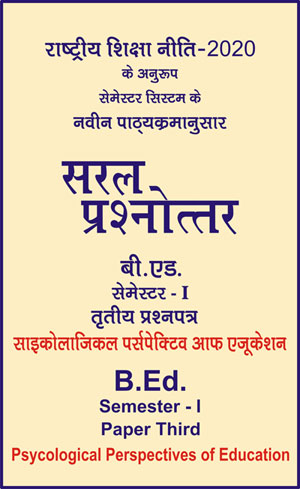|
बी एड - एम एड >> बी.एड. सेमेस्टर-1 प्रश्नपत्र-III - साइकोलाजिकल पर्सपेक्टिव आफ एजूकेशन बी.एड. सेमेस्टर-1 प्रश्नपत्र-III - साइकोलाजिकल पर्सपेक्टिव आफ एजूकेशनसरल प्रश्नोत्तर समूह
|
5 पाठक हैं |
|||||||
बी.एड. सेमेस्टर-1 प्रश्नपत्र-III - साइकोलाजिकल पर्सपेक्टिव आफ एजूकेशन (अंग्रेजी भाषा में)
Question- How will you motivate to your students as pupil teacher?
Or
What is the significance of motivation in educational process ?
Answer-
Motivation for students
Some students seem naturally enthusiastic about learning, but many need-or expect-their instructors to inspire, challenge, and stimulate them: Effective learning in the classroom depends on the teacher’s ability ... to maintain the interst that brought students to the course in the first place. Whatever level of motivation your students bring to the classroom will be transformed, for better or worse, by what happens in that classroom.
Unfortunately, there is no single magical formula for motivating students. Many factors affect a given student’s motivation to work and to learn : interest in the subject matter, perception of its usefulness, general desire to achieve, self-confidence and self-esteem, as well a patience and persistence. And, of course, not all students are motivated by the same values, needs, desires, or wants. Some of your students will be motivated by the approval of others, some by overcoming challenges.
To encourage students to become self-motivated independent learners, instructors can do the following
(1) Give frequent, early, positive feedback that supports student’s beliefs that they can do well.
(2) Ensure opportunities for student’s success by assigning tasks that are neither too easy nor too difficult.
(3) Help students find personal meaning and value in the material.
(4) Create an atmosphere that is open and positive.
(5) Help students feel that they are valued members of a learning community.
General Strategies for Student’s Motivation
Strategies for Student’s Motivation are as follows :
(1) Tailer Made Learning : Capitalize on student’s existing needs. Students learn best when incentives for learning in a classroom satisfy their own motives for enrolling in the course. Some of the needs your students may bring to the classroom are the need to learn something in order to complete a particular task or activity, the need to seek new experiences. the need to perfect skills, the need to overcome challenges, the need to become competent, the need to succeed and do well, the need to feel involved and to interact with other people. Satisfying such needs is rewarding in itself, and such rewards sustain learning more effectively than do grades. Design assignments, in-class activities, and discussion questions to address these kinds of needs.
(2) Participatory Learning : Make students active participants in learning. Students learn by doing, making, writing, designing, creating, solving, Passivity dampens student’s motivation and curiosity, Pose questions. Don’t tell students something when you can ask them. Encourage students to suggest approaches to a problem or to guess the results of an experiment. Use small group work. See “Leading a Discussion,” “Supplements and Alternatives to Lecturing,” and “Collaborative Learning” for methods that stress active participation.
(3) Self Assessment For Motivation : Ask students to analyze what makes their classes more or less “Motivating.” Sass asks his classes to recall two recent class periods, one in which they, were highly motivated and one in which their motivation, and students then meet in small groups to reach consensus on characteristics that contribute to high and low motivation. In over twenty courses, Sass reports the same eight characteristics emerge as major contributors to student motivation are Instructor’s enthusiasm, Relevance of the material, Organization of the course Appropriate difficulty level of the material, Active involvement of students, Report between teacher and students, Use of appropriate, concrete, and understandable examples.
|
|||||














